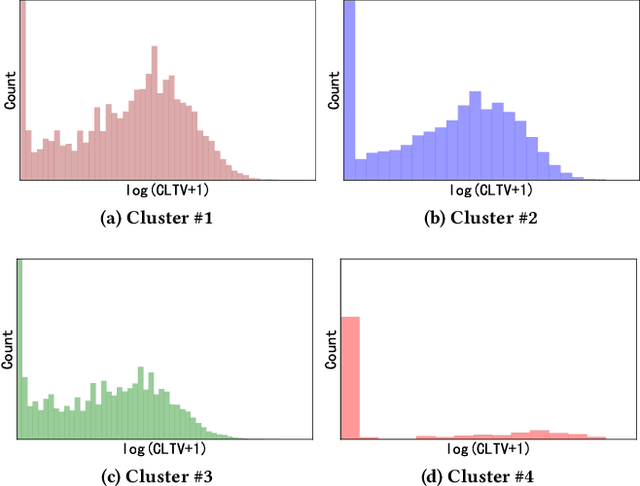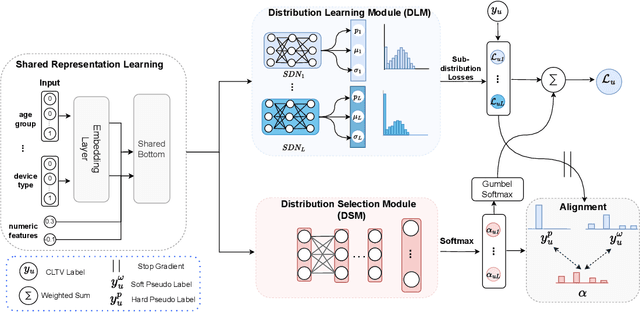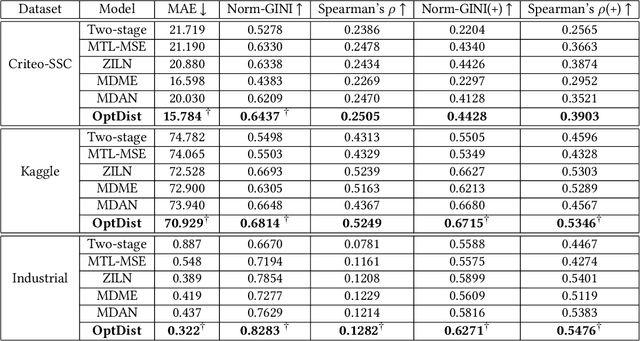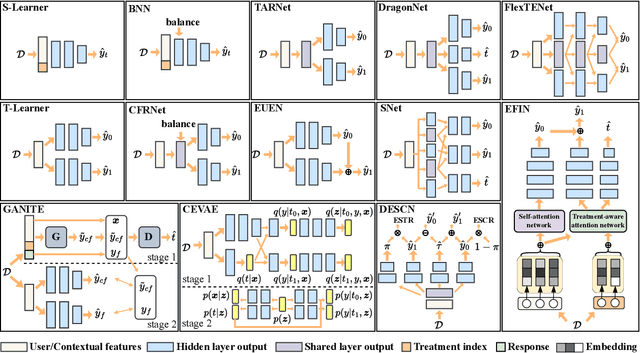Dugang Liu
See&Trek: Training-Free Spatial Prompting for Multimodal Large Language Model
Sep 19, 2025Abstract:We introduce SEE&TREK, the first training-free prompting framework tailored to enhance the spatial understanding of Multimodal Large Language Models (MLLMS) under vision-only constraints. While prior efforts have incorporated modalities like depth or point clouds to improve spatial reasoning, purely visualspatial understanding remains underexplored. SEE&TREK addresses this gap by focusing on two core principles: increasing visual diversity and motion reconstruction. For visual diversity, we conduct Maximum Semantic Richness Sampling, which employs an off-the-shell perception model to extract semantically rich keyframes that capture scene structure. For motion reconstruction, we simulate visual trajectories and encode relative spatial positions into keyframes to preserve both spatial relations and temporal coherence. Our method is training&GPU-free, requiring only a single forward pass, and can be seamlessly integrated into existing MLLM'S. Extensive experiments on the VSI-B ENCH and STI-B ENCH show that S EE &T REK consistently boosts various MLLM S performance across diverse spatial reasoning tasks with the most +3.5% improvement, offering a promising path toward stronger spatial intelligence.
BoRA: Towards More Expressive Low-Rank Adaptation with Block Diversity
Aug 09, 2025Abstract:Low-rank adaptation (LoRA) is a parameter-efficient fine-tuning (PEFT) method widely used in large language models (LLMs). It approximates the update of a pretrained weight matrix $W\in\mathbb{R}^{m\times n}$ by the product of two low-rank matrices, $BA$, where $A \in\mathbb{R}^{r\times n}$ and $B\in\mathbb{R}^{m\times r} (r\ll\min\{m,n\})$. Increasing the dimension $r$ can raise the rank of LoRA weights (i.e., $BA$), which typically improves fine-tuning performance but also significantly increases the number of trainable parameters. In this paper, we propose Block Diversified Low-Rank Adaptation (BoRA), which improves the rank of LoRA weights with a small number of additional parameters. Specifically, BoRA treats the product $BA$ as a block matrix multiplication, where $A$ and $B$ are partitioned into $b$ blocks along the columns and rows, respectively (i.e., $A=[A_1,\dots,A_b]$ and $B=[B_1,\dots,B_b]^\top$). Consequently, the product $BA$ becomes the concatenation of the block products $B_iA_j$ for $i,j\in[b]$. To enhance the diversity of different block products, BoRA introduces a unique diagonal matrix $\Sigma_{i,j} \in \mathbb{R}^{r\times r}$ for each block multiplication, resulting in $B_i \Sigma_{i,j} A_j$. By leveraging these block-wise diagonal matrices, BoRA increases the rank of LoRA weights by a factor of $b$ while only requiring $b^2r$ additional parameters. Extensive experiments across multiple datasets and models demonstrate the superiority of BoRA, and ablation studies further validate its scalability.
Semantic Retrieval Augmented Contrastive Learning for Sequential Recommendation
Mar 06, 2025Abstract:Sequential recommendation aims to model user preferences based on historical behavior sequences, which is crucial for various online platforms. Data sparsity remains a significant challenge in this area as most users have limited interactions and many items receive little attention. To mitigate this issue, contrastive learning has been widely adopted. By constructing positive sample pairs from the data itself and maximizing their agreement in the embedding space,it can leverage available data more effectively. Constructing reasonable positive sample pairs is crucial for the success of contrastive learning. However, current approaches struggle to generate reliable positive pairs as they either rely on representations learned from inherently sparse collaborative signals or use random perturbations which introduce significant uncertainty. To address these limitations, we propose a novel approach named Semantic Retrieval Augmented Contrastive Learning (SRA-CL), which leverages semantic information to improve the reliability of contrastive samples. SRA-CL comprises two main components: (1) Cross-Sequence Contrastive Learning via User Semantic Retrieval, which utilizes large language models (LLMs) to understand diverse user preferences and retrieve semantically similar users to form reliable positive samples through a learnable sample synthesis method; and (2) Intra-Sequence Contrastive Learning via Item Semantic Retrieval, which employs LLMs to comprehend items and retrieve similar items to perform semantic-based item substitution, thereby creating semantically consistent augmented views for contrastive learning. SRA-CL is plug-and-play and can be integrated into standard sequential recommendation models. Extensive experiments on four public datasets demonstrate the effectiveness and generalizability of the proposed approach.
A Predict-Then-Optimize Customer Allocation Framework for Online Fund Recommendation
Mar 05, 2025Abstract:With the rapid growth of online investment platforms, funds can be distributed to individual customers online. The central issue is to match funds with potential customers under constraints. Most mainstream platforms adopt the recommendation formulation to tackle the problem. However, the traditional recommendation regime has its inherent drawbacks when applying the fund-matching problem with multiple constraints. In this paper, we model the fund matching under the allocation formulation. We design PTOFA, a Predict-Then-Optimize Fund Allocation framework. This data-driven framework consists of two stages, i.e., prediction and optimization, which aim to predict expected revenue based on customer behavior and optimize the impression allocation to achieve the maximum revenue under the necessary constraints, respectively. Extensive experiments on real-world datasets from an industrial online investment platform validate the effectiveness and efficiency of our solution. Additionally, the online A/B tests demonstrate PTOFA's effectiveness in the real-world fund recommendation scenario.
Fusion Matters: Learning Fusion in Deep Click-through Rate Prediction Models
Nov 24, 2024Abstract:The evolution of previous Click-Through Rate (CTR) models has mainly been driven by proposing complex components, whether shallow or deep, that are adept at modeling feature interactions. However, there has been less focus on improving fusion design. Instead, two naive solutions, stacked and parallel fusion, are commonly used. Both solutions rely on pre-determined fusion connections and fixed fusion operations. It has been repetitively observed that changes in fusion design may result in different performances, highlighting the critical role that fusion plays in CTR models. While there have been attempts to refine these basic fusion strategies, these efforts have often been constrained to specific settings or dependent on specific components. Neural architecture search has also been introduced to partially deal with fusion design, but it comes with limitations. The complexity of the search space can lead to inefficient and ineffective results. To bridge this gap, we introduce OptFusion, a method that automates the learning of fusion, encompassing both the connection learning and the operation selection. We have proposed a one-shot learning algorithm tackling these tasks concurrently. Our experiments are conducted over three large-scale datasets. Extensive experiments prove both the effectiveness and efficiency of OptFusion in improving CTR model performance. Our code implementation is available here\url{https://github.com/kexin-kxzhang/OptFusion}.
Comprehending Knowledge Graphs with Large Language Models for Recommender Systems
Oct 16, 2024Abstract:Recently, the introduction of knowledge graphs (KGs) has significantly advanced recommender systems by facilitating the discovery of potential associations between items. However, existing methods still face several limitations. First, most KGs suffer from missing facts or limited scopes. This can lead to biased knowledge representations, thereby constraining the model's performance. Second, existing methods typically convert textual information into IDs, resulting in the loss of natural semantic connections between different items. Third, existing methods struggle to capture high-order relationships in global KGs due to their inefficient layer-by-layer information propagation mechanisms, which are prone to introducing significant noise. To address these limitations, we propose a novel method called CoLaKG, which leverages large language models (LLMs) for knowledge-aware recommendation. The extensive world knowledge and remarkable reasoning capabilities of LLMs enable them to supplement KGs. Additionally, the strong text comprehension abilities of LLMs allow for a better understanding of semantic information. Based on this, we first extract subgraphs centered on each item from the KG and convert them into textual inputs for the LLM. The LLM then outputs its comprehension of these item-centered subgraphs, which are subsequently transformed into semantic embeddings. Furthermore, to utilize the global information of the KG, we construct an item-item graph using these semantic embeddings, which can directly capture higher-order associations between items. Both the semantic embeddings and the structural information from the item-item graph are effectively integrated into the recommendation model through our designed representation alignment and neighbor augmentation modules. Extensive experiments on four real-world datasets demonstrate the superiority of our method.
OptDist: Learning Optimal Distribution for Customer Lifetime Value Prediction
Aug 16, 2024



Abstract:Customer Lifetime Value (CLTV) prediction is a critical task in business applications. Accurately predicting CLTV is challenging in real-world business scenarios, as the distribution of CLTV is complex and mutable. Firstly, there is a large number of users without any consumption consisting of a long-tailed part that is too complex to fit. Secondly, the small set of high-value users spent orders of magnitude more than a typical user leading to a wide range of the CLTV distribution which is hard to capture in a single distribution. Existing approaches for CLTV estimation either assume a prior probability distribution and fit a single group of distribution-related parameters for all samples, or directly learn from the posterior distribution with manually predefined buckets in a heuristic manner. However, all these methods fail to handle complex and mutable distributions. In this paper, we propose a novel optimal distribution selection model OptDist for CLTV prediction, which utilizes an adaptive optimal sub-distribution selection mechanism to improve the accuracy of complex distribution modeling. Specifically, OptDist trains several candidate sub-distribution networks in the distribution learning module (DLM) for modeling the probability distribution of CLTV. Then, a distribution selection module (DSM) is proposed to select the sub-distribution for each sample, thus making the selection automatically and adaptively. Besides, we design an alignment mechanism that connects both modules, which effectively guides the optimization. We conduct extensive experiments on both two public and one private dataset to verify that OptDist outperforms state-of-the-art baselines. Furthermore, OptDist has been deployed on a large-scale financial platform for customer acquisition marketing campaigns and the online experiments also demonstrate the effectiveness of OptDist.
Masked Random Noise for Communication Efficient Federaetd Learning
Aug 06, 2024Abstract:Federated learning is a promising distributed training paradigm that effectively safeguards data privacy. However, it may involve significant communication costs, which hinders training efficiency. In this paper, we aim to enhance communication efficiency from a new perspective. Specifically, we request the distributed clients to find optimal model updates relative to global model parameters within predefined random noise. For this purpose, we propose Federated Masked Random Noise (FedMRN), a novel framework that enables clients to learn a 1-bit mask for each model parameter and apply masked random noise (i.e., the Hadamard product of random noise and masks) to represent model updates. To make FedMRN feasible, we propose an advanced mask training strategy, called progressive stochastic masking (PSM). After local training, each client only need to transmit local masks and a random seed to the server. Additionally, we provide theoretical guarantees for the convergence of FedMRN under both strongly convex and non-convex assumptions. Extensive experiments are conducted on four popular datasets. The results show that FedMRN exhibits superior convergence speed and test accuracy compared to relevant baselines, while attaining a similar level of accuracy as FedAvg.
A Practice-Friendly Two-Stage LLM-Enhanced Paradigm in Sequential Recommendation
Jun 01, 2024Abstract:The training paradigm integrating large language models (LLM) is gradually reshaping sequential recommender systems (SRS) and has shown promising results. However, most existing LLM-enhanced methods rely on rich textual information on the item side and instance-level supervised fine-tuning (SFT) to inject collaborative information into LLM, which is inefficient and limited in many applications. To alleviate these problems, this paper proposes a novel practice-friendly two-stage LLM-enhanced paradigm (TSLRec) for SRS. Specifically, in the information reconstruction stage, we design a new user-level SFT task for collaborative information injection with the assistance of a pre-trained SRS model, which is more efficient and compatible with limited text information. We aim to let LLM try to infer the latent category of each item and reconstruct the corresponding user's preference distribution for all categories from the user's interaction sequence. In the information augmentation stage, we feed each item into LLM to obtain a set of enhanced embeddings that combine collaborative information and LLM inference capabilities. These embeddings can then be used to help train various future SRS models. Finally, we verify the effectiveness and efficiency of our TSLRec on three SRS benchmark datasets.
Benchmarking for Deep Uplift Modeling in Online Marketing
Jun 01, 2024



Abstract:Online marketing is critical for many industrial platforms and business applications, aiming to increase user engagement and platform revenue by identifying corresponding delivery-sensitive groups for specific incentives, such as coupons and bonuses. As the scale and complexity of features in industrial scenarios increase, deep uplift modeling (DUM) as a promising technique has attracted increased research from academia and industry, resulting in various predictive models. However, current DUM still lacks some standardized benchmarks and unified evaluation protocols, which limit the reproducibility of experimental results in existing studies and the practical value and potential impact in this direction. In this paper, we provide an open benchmark for DUM and present comparison results of existing models in a reproducible and uniform manner. To this end, we conduct extensive experiments on two representative industrial datasets with different preprocessing settings to re-evaluate 13 existing models. Surprisingly, our experimental results show that the most recent work differs less than expected from traditional work in many cases. In addition, our experiments also reveal the limitations of DUM in generalization, especially for different preprocessing and test distributions. Our benchmarking work allows researchers to evaluate the performance of new models quickly but also reasonably demonstrates fair comparison results with existing models. It also gives practitioners valuable insights into often overlooked considerations when deploying DUM. We will make this benchmarking library, evaluation protocol, and experimental setup available on GitHub.
 Add to Chrome
Add to Chrome Add to Firefox
Add to Firefox Add to Edge
Add to Edge